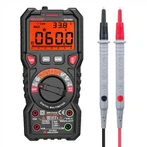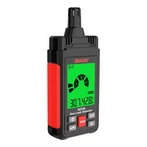How to use a multimeter to distinguish the quality of capacitors
I don't know how to use a multimeter to distinguish between good and bad capacitors, especially those that exceed the range of a multimeter. Today, I will tell you how to use a multimeter to distinguish between good and bad capacitors, especially those with larger capacities. Without much nonsense, I will go straight to the topic.
Direct observation to distinguish
If a general capacitor is damaged, it can be distinguished from its appearance. The most obvious feature is that it will crack and have obvious signs of damage. For example, the following image is a live shot of a capacitor explosion, which is easy to distinguish. Many capacitors in the circuit are also damaged due to explosions, so this method is still very useful.
Using a multimeter capacitance range to distinguish
For capacitors with smaller capacity, it is actually possible to directly use the capacitance range of a multimeter to distinguish them. Measuring capacitance with a multimeter is relatively simple. Even if the capacitor is distinguished between positive and negative poles, the multimeter does not distinguish between positive and negative poles when measuring it. The capacity size of the capacitance is usually marked on the outside of the capacitor, so it can be compared based on the capacity size measured by the multimeter and the marked size. If there is a significant difference between the two, Or if the data cannot be measured at all, it can be concluded that the measured capacitance has been broken. On the contrary, if the capacitance is relatively close, then this capacitance is good.
Using diode range to distinguish
The previous method may be very reliable, but when the capacitance exceeds the range of the multimeter when the capacity is large, this method is no longer feasible. It doesn't matter. We have another method, which is to use a diode range for measurement. The measurement method is similar to that of measuring capacitance, but it is slightly different. When using a capacitor range for measurement, there is no need to distinguish the positive and negative poles of the capacitor, but this distinguishes, Place the black lead on the positive pole of the capacitor (when using an internal power supply, current flows out of the black lead) and the red lead on the negative pole of the capacitor. If you see the number on the dial of the multimeter constantly increasing, and the larger the capacity, the more obvious this phenomenon is, then you can conclude that the capacitor is good.
Using resistance to distinguish
In addition to the three methods mentioned above, you can also use a resistance range for measurement. Surprisingly, this method is very similar to using a diode range for measurement. It also distinguishes between positive and negative poles, connecting a black lead to the positive pole of the capacitor and a red lead to the negative pole of the capacitor. Choose the appropriate resistance range, and in the test, I chose the 20K gear. This phenomenon is very obvious when measuring, and it can be clearly seen on the multimeter display screen that this number is increasing, If the capacity of the capacitor is larger, this phenomenon will be more obvious and the growth rate will be slower.






